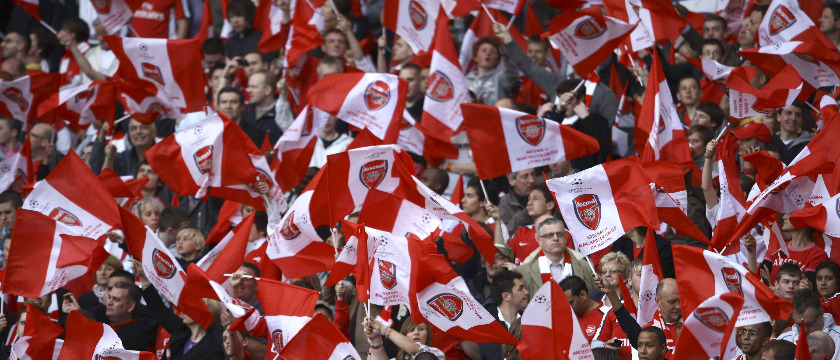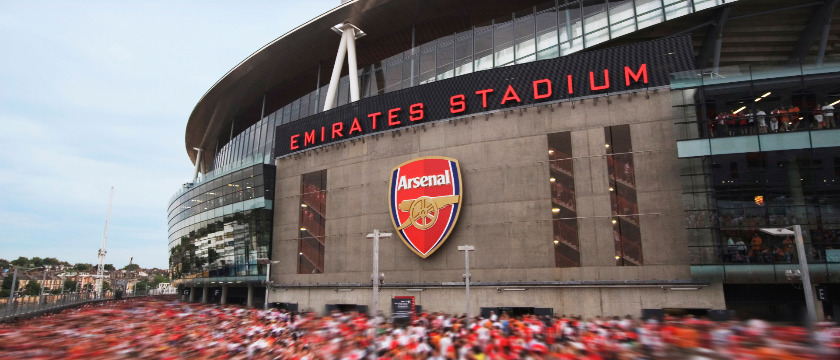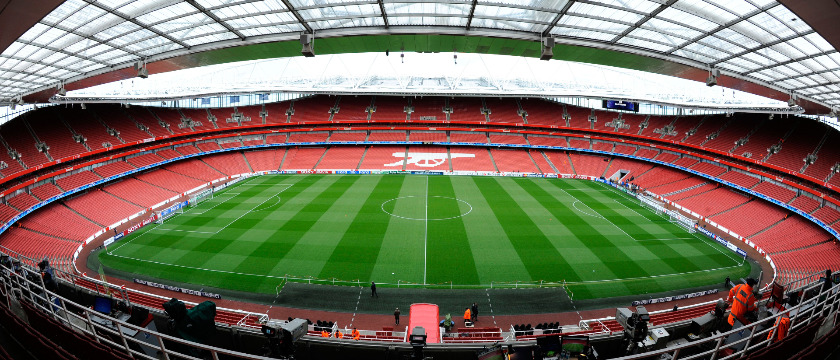Travel Guide for Arsenal and The Emirates Stadium in London
Below you will find your perfect guide for going to England to watch Arsenal at the Emirates Stadium!
Headlines from the travel guide:

Arsenal Honours
First Division/ Premier League: 13 (last 2004)
FA Cup: 13 (last 2017)
League Cup: 2 (last 1993)
Cup Winners Cup: 1 (1994)
Emirates Stadium
Capacity: 60,362
Pitch: 105 x 68 m
Opening match: July 22, 2006 (Arsenal – Ajax 2-1)
Emirates Stadium
London
N5 1BU
Emirates Stadium History
Emirates Stadium was opened in July 2006. The stadium has since won numerous of awards such as Best Built Project Contributing to London’s Future and Project of the Year (2007 Building Awards). The arena is situated in the Borough of Islington, Arsenal’s home since 1913.
Emirates Stadium cost Arsenal £390 million to build. The field dimensions are 113 x 76 metres, while at Highbury it measured 105 x 70 metres. Inside the stadium there are 250 serving stations offering food and there are more than 900 toilets.
There are 41 TV camera positions, as well as 215 seats for the media. The size of the roof is 30 000 square meters. the height of the stadium is 41.9 metres from pitch level to the top of the roof.
As a memorial to classic Highbury, the Arsenal Clock is now on the outside of the Emirates. It previously graced the old stadium’s south stand, also known as the Clock End. Inside the Emirates is a larger version of the original clock.

EMIRATES STADIUM DIRECTIONS
The easiest way to plan your trip to the Emirates Stadium is to use the excellent Journey Planner Transport for London provides: www.tfl.gov.uk. Travel planning is also available for wheelchair supporters.
Tube:
Arsenal (Piccadilly Line): Within 3 minutes walking distance from the stadium.
Finsbury Park (Victoria Line, Piccadilly Line and Great Northern rail): A 10 minute walk to the stadium.
Highbury & Islington (Victoria Line, Northern Line and Great Northern rail): Within 10 minutes walking distance from the stadium.
EMIRATES STADIUM BARS
There are plenty of food and drink serving points at the Emirates Stadium, 250 to be precise. There is everything from snacks to luxury meals available. However, the restaurants are open to club members only. Other spectators have to stick to hot dogs, pizzas and other snacks.
A walk along Blackstock Road before the game, will give you a brilliant option to find a nice pub.
Here you will be able to find (street numbers in brackets)
The Gunners (204)
Kings Head (126)
The Arsenal Tavern (175)
The Woodbine (215)
The Bank of Friendship (224)
Another tip is El Comandante (10 Annette Road), formerly known as Lord Palmerston.
Good pubs for away supporters are Drayton Arms (by Drayton Park station), Twelve Pins (263 Seven Sisters Road) and Blackstock (259 Seven Sisters Road) – the last two pubs are near Finsbury Park tube station.
EMIRATES STADIUM TOUR
Self-Guided Audio Tour (including museum):
£20.00 – adults
£10.00 – children
Family ticket (2 adults and 2 children) £50.00
Booking: +44 (0)20 7619 5000 or www.arsenal.com/emirates
There are also Legends tours available, i.e. tours with legendary Arsenal players as guides. With these tours you will receive a “limited edition Legends tour gift”. The tour guides you can choose between are Charlie George, Nigel Winterburn, Perry Groves and Lee Dixon.
All those above have won league and/or cup titles with Arsenal. But quality costs: the price for a Legends tour is £40.00 (£20.00 for Children /seniors).

ARSENAL MUSEUM
The spectacular Arsenal museum is located in the Northern Triangle Building at the Emirates Stadium. Here you will find classic items such as Michael Thomas’ boots from Anfield 89, Charlie George’s FA Final shirt from 1971 and Alan Smith’s shirt from the Cup Winners Cup Final in 1994.
There is also a customised trophy on display that was presented to the club by the FA Premier League for remaining unbeaten throughout the 2003/04 season.
£10.00 – adults
£7.00 – children /seniors
Monday – Saturday: 10.30-18.00
Sunday: 10.30-16.30
ARSENAL STORES OPENING TIMES
The Armoury
Emirates Stadium
Hornsey Road
London
N7 7AJ
The Armoury is located below the concourse on the west side of the stadium (Holloway Road).
The Arsenal at Highbury House
75 Drayton Park
London
N5 1BU
The Arsenal Finsbury Park
Station Place
Finsbury Park
London
N4 2DH
Monday – Saturday: 9:00 – 18:00
Sunday: 10:00 – 16:00
ARSENAL TRAINING GROUND
Arsenal’s training ground is located near Shenley in Hertfordshire. It has ten pitches, two with undersoil heating. Each pitch is built to the exact specifications of the playing surface at Emirates Stadium.
Three of the pitches are reserved for the first team, three for the reserves and three for the youth team. The tenth is for friendlies and youth team matches.
Apart from a gym, swimming pool, massage/physiotherapy rooms and a restaurant there are also spaces for media. At the training complex there are 10 different interview rooms and a press conference room, seating up to 100 people. One of the latest additions is a state-of-the-art medical centre.
ARSENAL CLUB HISTORY
The history of Arsenal Football Club begins in the suburbs of south-east London in 1886. A group of workers from the ammunition factory in Woolwich collected enough money between themselves to set up the football club, Dial Square. The name Dial Square came from the ammunition factory’s own shop where most of the Scottish workers did their daily shopping.
David Danskin was one of the workers at the Woolwich Arsenal Armament Factory, one of England’s main ammunition factories. Together with a group of other football interested scots he formed a football team within the factory. At the time rugby and cricket were the most popular sports in the county of Kent and this meant that football had to stand in the shadow of these sports.
The turning point came when two former Nottingham Forest players, Fred Beardsley and Morris Bates, moved to Woolwich and started working at the factory. This inspired David Danskin and his three friends Elijah Watkins, John Humble and Richard Pearce to explore the interest among the other workers. Word got around and 15 men came forward, each prepared to pay sixpence to help start up a club.
Fred Beardsley had previously been employed at the factory in Woolwich Arsenal. He had moved to London from Nottingham where he had been working together with Norris Bates at a similar factory located by Trent Bridge, right next to Nottingham Forest’s old ground. Many years later, Fred told his grandson that during his first employment at the factory he had helped to form a club called Woolwich Union. The club had been playing their games at ‘Piggy’ Walton’s Field in Plumstead. It’s believed that many of the players involved with Dial Square were the same ones that had played for Woolwich Union.
Arsenal’s first game
The club played their first game on December 11, 1886 against Eastern Wanderers, who they crushed 6-0 on a real messy pitch. That is literally speaking as it had an open sewer running through the middle of it.
The club members were in good spirits after the win and on Christmas Day they all got together in the Royal Oak pub, right next to the Woolwich / Arsenal tube station, to make a decision about the club’s future. At that time the club had no real home ground, no club kit to wear and a name nobody really liked. All this was sorted out during the meeting and the club changed its name to Royal Arsenal.
The former Nottingham Forest players Morris Bates and Fred Beardsley wrote to their old club and asked if they could help out, in return they received complete match kits and a new football. The kits were in Nottingham Forest ́s red colours and this is the reason why Arsenal wear red to this day. A field near Plumstead Common was chosen as the club’s first home ground.
Arsenal’s connection to the army, and the fact that they are called the Gunners, is down to the area where the ammunition factory was located. It had the Royal Navy dockyards, the Royal Military Academy, the Royal Artillery and a number of military hospitals. At the time when the club was formed, there were no less than 28 military units in the area.
Arsenal move to Highbury
The club turned professional in 1891 and the name was changed to Woolwich Arsenal. In 1893 the club joined the Football League and started out in the second division. The owner Henry Norris wanted to move to a more attractive location which was easier to reach from central London. so, in 1913 the club crossed the River Thames and moved to the Borough of Islington, north London and to the classic football ground Highbury.
After the First World War, when the number of teams in the first division was increased, Arsenal were voted into the top division. The decision was taken after vigorous lobbying, which in the end meant that Arsenal were promoted to the first division at the expense of their bitter rivals Tottenham, who had just been relegated.
Arsenal have stayed in the top division of English football ever since. The outcome of the vote in 1919 is still talked about among Tottenham fans to this day…
The legendary manager Herbert Chapman laid the foundations for Arsenal’s dominance of English football during the thirties. This era began with victory in the 1930 FA Cup final: 2-0 against Huddersfield Town, the club Chapman lad led to two league titles before he came to Arsenal in 1925.
The success continued, five league titles (including three in a row) and another FA Cup being achieved during this golden decade.
Arsenal: The Wenger years
The club’s only major European title was won in 1994 at Parken in Copenhagen. The opponents were Tomas Brolin’s Parma where Alan Smith scored the only goal to seal victory.
Sixty years after Herbert Chapman’s time a new manager took the club to new feats: Arsene Wenger. During the period 1998 – 2005 Arsenal won seven titles. With players like Dennis Bergkamp, Thierry Henry and Fredrik Ljungberg the Gunners played football that was both elegant and successful.
Since then, and a move to the Emirates Stadium, silverware has been harder to come by. However, they have lifted the FA Cup twice more in recent years and regular fixtures in the Champions League, including an appearance in the final.
Wenger leaves
The 2017/18 season started well for Arsenal but once again domestic results tailed off and, with a poor away record, their hopes of a Champions League finish soon disappeared. Their run in the Europa League was ended by Atletico Madrid in the semi-finals. This marked the end of Wenger’s 22 years in charge of Arsenal and he was given a warm ovation after his final home game at the Emirates, a 5-0 win over Burnley.
In May Arsenal appointed his successor: Unai Emery had won three successive Europa League titles at Sevilla, and in 2018 he won all four French domestic trophies at PSG. His arrival signalled a number of new player signings at the Emirates as the club embark on a new era.
ARSENAL FACTS
During the 1929-30 season, an Arsenal – Leicester game finished 6-6. For a game to finish as a draw, this one has the highest number of goals scored in the league’s history.
On December 14, 1935 Arsenal won 7-1 against Aston Villa. The Gunners’ notorious goalscorer Ted Drake scored all seven goals and on top of that he also hit the bar once.
With 228 goals Thierry Henry is Arsenal’s top scorer of all time and when he came back in 2012 for a short loan period, he could admire his own statue outside the Emirates.
The Arsenal fans maliciously celebrate “St Totteringham’s Day” every time it has become mathematically impossible for Tottenham to finish above Arsenal in the league table.
Arsenal have won the Double three times: 1971, 1998 and 2002.
During a magical period between May 2003 and October 2004 Arsenal went unbeaten in 49 consecutive Premier League games. The run included all of the 2003/04 season and this feat earned them the nickname of “The Invincibles”.